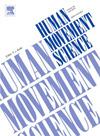Effects of freezing of gait on vertical ground reaction force in Parkinson's disease
IF 1.9
3区 心理学
Q4 NEUROSCIENCES
引用次数: 0
Abstract
Vertical ground reaction force (vGRF) is a main kinetic gait analysis explaining body weight loading patterns. The study primarily aimed to understand effects of Freezing of gait (FoG) on vGRF in Parkinson's disease (PD). A secondary analysis for a walking dataset including biomechanical analyses for 26 PD participants (13 with FoG) was performed. Considering the normal pattern of vGRF curve, peaks during early stance (F1) and late stance (F3), and slope in- during mid-stance (F2) were used to represent the change in kinetic forces. vGRF parameters were compared between FoG and non-FoG participants, and at off- and on-medication. FoG participants showed higher vGRFs during mid-stance F2 magnitude (p = 0.003), and weaker vertical propulsion; F3 magnitude (p < 0.001). This coincided with delayed weight acceptance; F1 timing (p = 0.019), and midstance peaks; F2 timing (p = 0.004). At off-medications, the F2 magnitude was significantly higher (p = 0.006), F3 magnitude lower (p = 0.001), and F1 time slower (p = 0.034) in FoG. At on-medication, F3 magnitude was still significantly lower (p = 0.017), and F2 time was slower (p = 0.037) in FoG. This study reveals that FoG significantly affects vGRF, particularly F3 magnitude during the push-off phase. Analyzing vGRF is crucial for understanding and managing FoG, allowing for more targeted interventions to improve FoG outcomes.
冻结步态对帕金森病患者垂直地面反作用力的影响
垂直地面反作用力(vGRF)是解释体重负荷模式的主要运动步态分析方法。本研究的主要目的是了解帕金森病(PD)患者步态冻结(FoG)对 vGRF 的影响。研究还对 26 名帕金森病患者(其中 13 人患有 FoG)的步行数据集进行了二次分析,包括生物力学分析。考虑到vGRF曲线的正常模式,早期站立(F1)和晚期站立(F3)时的峰值以及中期站立(F2)时的斜率被用来表示运动力的变化。FoG 参与者在中段站立时表现出更高的 vGRF,F2 幅值(p = 0.003),而垂直推进力较弱;F3 幅值(p < 0.001)。这与体重接受延迟(F1 时间)(p = 0.019)和中段站立峰值(F2 时间)(p = 0.004)相吻合。在非药物治疗时,FoG 的 F2 幅值明显更高(p = 0.006),F3 幅值更低(p = 0.001),F1 时间更慢(p = 0.034)。在用药时,FoG 的 F3 幅值仍然明显较低(p = 0.017),F2 时间较慢(p = 0.037)。本研究揭示了 FoG 对 vGRF 的显著影响,尤其是在推离阶段的 F3 幅值。分析 vGRF 对了解和管理 FoG 至关重要,可以采取更有针对性的干预措施来改善 FoG 的结果。
本文章由计算机程序翻译,如有差异,请以英文原文为准。
求助全文
约1分钟内获得全文
求助全文
来源期刊

Human Movement Science
医学-神经科学
CiteScore
3.80
自引率
4.80%
发文量
89
审稿时长
42 days
期刊介绍:
Human Movement Science provides a medium for publishing disciplinary and multidisciplinary studies on human movement. It brings together psychological, biomechanical and neurophysiological research on the control, organization and learning of human movement, including the perceptual support of movement. The overarching goal of the journal is to publish articles that help advance theoretical understanding of the control and organization of human movement, as well as changes therein as a function of development, learning and rehabilitation. The nature of the research reported may vary from fundamental theoretical or empirical studies to more applied studies in the fields of, for example, sport, dance and rehabilitation with the proviso that all studies have a distinct theoretical bearing. Also, reviews and meta-studies advancing the understanding of human movement are welcome.
These aims and scope imply that purely descriptive studies are not acceptable, while methodological articles are only acceptable if the methodology in question opens up new vistas in understanding the control and organization of human movement. The same holds for articles on exercise physiology, which in general are not supported, unless they speak to the control and organization of human movement. In general, it is required that the theoretical message of articles published in Human Movement Science is, to a certain extent, innovative and not dismissible as just "more of the same."
 求助内容:
求助内容: 应助结果提醒方式:
应助结果提醒方式:


